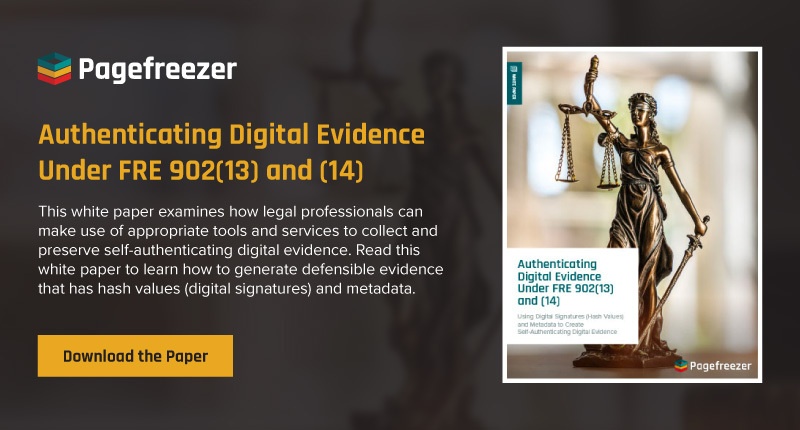SHA-256 is one of the most widely used cryptographic hashing algorithms, playing a crucial role in securing digital information. Part of the Secure Hash Algorithm 2 (SHA-2) family, SHA-256 ensures data integrity, safeguards sensitive information, and authenticates digital evidence and records in legal and compliance scenarios.
In this article, we’ll explore the fundamentals of SHA-256, including how it works, its security advantages, and its role in evidence authentication. We’ll answer key questions such as:
- Is SHA-256 secure?
- Can SHA-256 be reversed?
- What’s the difference between SHA-1 and SHA-2 hashing algorithms?
By the end of this article, you’ll have a clear understanding of why SHA-256 is the standard for ensuring the integrity and authenticity of digital records—and why it remains the preferred choice in security-sensitive industries.
Jump to:
- What is SHA-256?
- Understanding Hash Values
- Benefits of SHA-256
- How SHA-256 Works
- Example of a SHA-256 Hash Value
- SHA-256 vs Other Hashing Algorithms (SHA-1 vs SHA-2, and More)
- SHA-256 in Digital Evidence and Compliance
- TL;DR: Key Takeaways
- How Pagefreezer Uses SHA-256
- SHA-256 Frequently Asked Questions (FAQs)
What Is SHA-256?
SHA-256 is a cryptographic hashing algorithm that belongs to the Secure Hash Algorithm 2 (SHA-2) family, developed by the National Institute of Standards and Technology (NIST). It is designed to generate a fixed-length, 256-bit hash value from any input, regardless of size. This makes it an essential tool for ensuring data integrity, as even a tiny change in the input produces a completely different hash value.
Unlike encryption, which is reversible, SHA-256 is a one-way function. Once data is hashed, it cannot be converted back to its original form. This property makes it highly secure and widely used across various industries for data protection and verification.
SHA-256 is a critical component in multiple security-sensitive applications, including:
- Cybersecurity (password hashing): Many systems use SHA-256 to store passwords securely. Instead of storing plaintext passwords, systems hash them so that even if a database is compromised, attackers cannot easily recover the original passwords.
- Blockchain (Bitcoin mining & transactions): SHA-256 is the backbone of Bitcoin and other blockchain networks. It is used in mining to validate transactions and secure the integrity of digital ledgers, preventing fraud and unauthorized changes.
- Digital forensics and evidence authentication: In legal and compliance settings, SHA-256 ensures that digital records remain untampered. By generating unique hash values for documents and evidence, investigators can verify authenticity and prove that data has not been altered.
Because of its strong security and reliability, SHA-256 is the industry standard for hashing, trusted by governments, businesses, and cybersecurity professionals worldwide.
Understanding Hash Values
A hash value is a fixed-length string of numbers and letters generated from a mathematical algorithm applied to data. It serves as a unique identifier for digital information, ensuring data integrity and authenticity. Even the smallest change to the original data results in a completely different hash, making it a powerful tool for cybersecurity, digital forensics, and evidence authentication.
Characteristics of Hash Values
- Deterministic output: The same input will always produce the same hash value, allowing for consistent verification.
- Fixed length: Regardless of input size, SHA-256 always generates a 256-bit (64-character) hash.
- Collision resistance: The probability of two different inputs producing the same hash—known as the SHA256 collision probability—is so low that it’s considered practically impossible.
- Avalanche effect: Even a tiny change in the input—such as a single character difference—will result in a drastically different hash value.
- One-way function: A hash value cannot be reversed to reveal the original input, ensuring security in applications like password hashing and digital signatures.
Hash values are used across cybersecurity, blockchain, and digital forensics to verify data integrity and prevent tampering. In legal and compliance settings, they authenticate digital evidence, ensuring that files and records remain unchanged.
The Benefits of SHA-256 Hashing
The SHA-256 algorithm is widely recognized for its security, reliability, and resistance to attacks, making it a trusted standard across industries. These five main benefits make it the hashing algorithm of choice for cybersecurity, digital forensics, and compliance:
1. Trusted by the Most Security-Oriented Industries
SHA-256 is the hashing algorithm of choice for government agencies, financial institutions, and technology firms. It is widely used in blockchain security, password hashing, digital signatures, and evidence authentication.
2. Low Collision Probability
SHA-256 hashes have strong resistance to brute-force attacks and collision vulnerabilities, making it one of the most secure hashing algorithms in use today. A collision occurs when two different inputs generate the same hash value—a significant weakness in older algorithms like SHA-1 and MD5. SHA-256 is designed to make collisions virtually impossible due to its large number of possible hash values.
3. The Avalanche Effect Ensures Integrity
One of the defining features of SHA-256 is the avalanche effect, which ensures that even the smallest change to the input results in a drastically different hash value. This property prevents predictable patterns that attackers could exploit, reinforcing data integrity by ensuring that even minor modifications to a document or transaction produce a completely new, unique hash.
4. Pre-Image Resistance
Pre-image resistance means that reversing the hash is computationally impossible, keeping your data safe. If a hashing algorithm lacks pre-image resistance, attackers can potentially reverse-engineer sensitive data (like passwords), making systems vulnerable.
5. Legal Defensibility
In U.S. legal proceedings, SHA-256 is recognized as a valid method of authenticating electronic evidence. Recent amendments to the Federal Rules of Evidence (FRE 902(13) and (14)) allow hash values to serve as proof that digital records have not been altered, reducing the need for live expert testimony. These amendments highlight the legal importance of hash-based authentication, making SHA-256 a foundational tool for verifying the authenticity of evidence.
How SHA-256 Works
Think of SHA-256 hashing like a high-tech fingerprint for digital information. It takes any input—whether it’s a word, sentence, file, or even an entire document—and converts it into a unique 64-character code, the hash value. Note that a 256-hash value is always the same length, no matter the size of the original input.
Here’s how the SHA-256 algorithm works:
1. Pre-processing (padding the input)
- Computers work with fixed-size blocks of data. If your input is too short, SHA-256 adds extra bits (called padding) to ensure it fits neatly into 512-bit chunks.
- This step helps standardize all inputs, whether they’re short phrases or long documents.
2. Processing in blocks
- The padded data is split into 64 smaller chunks (called "words").
- Each chunk goes through multiple rounds of complex mathematical operations to mix up the data in a controlled way.
-
These operations involve bitwise shifts, logical functions, and modular addition, all designed to create an unpredictable but repeatable transformation.
3. Processing in blocks
- After 64 rounds of processing, SHA-256 produces a 256-bit (or 64-character hexadecimal) hash.
- This final hash value uniquely represents the original input and cannot be reversed, ensuring data integrity.
Example of a SHA-256 Hash Value
Let’s take a simple phrase and see what SHA-256 hash value is generated:
- Input: "Hello, world!"
- SHA-256 Hash:
64EC88CA00B268E5BA1A35678A1B5316D212F4F366B24772340327B57511F1DF
Now, let’s change one character and see how the hash completely changes:
- Input: "Hello, World!" (uppercase "W")
- SHA-256 Hash:
7F83B1657FF1FC53B92DC18148A1D065CF62DABBAE261C7B828A1953FDAD60A6
Even though the difference is just one letter, the hash is entirely different—showcasing the avalanche effect discussed earlier.
If you'd like to try it out for yourself, check out this free hash value generator: https://www.toolsley.com/hash.html
SHA-256 vs Other Hashing Algorithms (SHA-1 vs SHA-2, and More)
Not all hashing algorithms offer the same level of security. When comparing SHA-2 vs SHA-1, it becomes evident why SHA-2, particularly SHA-256, is the preferred choice.
Why the SHA-1 Hashing Algorithm is Not Secure
SHA-1 is no longer considered secure because in 2017, Google successfully demonstrated the first practical SHA-1 collision attack, proving that two different files could have the same hash value. Advances in computing power have made it easier to find SHA-1 collisions, reducing its reliability for security-sensitive applications.
NIST officially deprecated SHA-1, urging organizations to migrate to SHA-2 algorithms like SHA-256.
This video provides a good overview of the SHA-1 collision.
If you’re looking for a deeper dive, you can also have a look at this detailed presentation by the team responsible for the collision.
You can also download this handy reference guide for a more complete explanation.
Why the MD5 Hashing Algorithm is Not Secure
The issue with MD5 is that it is very susceptible to intentional collisions—known as collision attacks—where attackers try to create two different inputs that produce the same hash value. In fact, a basic computer and a tool like HashClash can now generate collisions in no time at all—we’re talking about minutes, if not seconds.
SHA-2: The Evolution of Secure Hashing
SHA-2 (Secure Hash Algorithm 2) is an improved version of SHA-1, designed to address its vulnerabilities. SHA-2 includes multiple variants with different hash lengths:
- SHA-224
- SHA-256 (256-bit hash, the most widely used)
- SHA-384
- SHA-512
Unlike SHA-1, the SHA-2 family is resistant to collision attacks and provides stronger security guarantees, making it the preferred choice for data integrity and cryptographic applications.
|
Hashing Algorithm |
Bit Length |
Collision Vulnerability |
Security Status |
|
MD5 |
128-bit |
Broken; collisions easily generated |
Insecure |
|
SHA-1 |
160-bit |
First collision attack in 2017 |
Deprecated |
|
SHA-256 |
256-bit |
No known collisions |
Secure & widely used |
|
SHA-512 |
512-bit |
More secure but computationally heavier |
Highly secure |
Because SHA-256 offers strong collision resistance, pre-image resistance, and computational efficiency, it remains the preferred choice for cybersecurity, digital forensics, and legal compliance.
Is SHA-256 Secure? Applications in Digital Evidence and Compliance
In digital forensics, legal investigations, and compliance, ensuring the authenticity and integrity of electronic records is critical. SHA-256 plays a key role in this process by generating unique hash values that act as digital fingerprints for files, documents, and communications.
One of the most important applications of SHA-256 is in digital signatures, where hash values are used to verify that a document has not been altered. In legal proceedings, the chain of custody is essential for proving the reliability of digital evidence—and SHA-256 ensures that any changes to a document or record can be detected immediately.
To learn more check out this article: Why Hash Values Are Crucial in Digital Evidence Authentication
TL;DR: Why SHA-256 Is the Trusted Standard for Data Integrity
SHA-256 is the gold standard for data integrity, security, and digital evidence authentication. Its collision-resistant, one-way hashing algorithm ensures that electronic records remain tamper-proof and verifiable, making it indispensable in cybersecurity, legal compliance, and digital forensics.
Key Takeaways
- Unmatched data security: SHA-256’s collision resistance and irreversibility ensure that digital records remain tamper-proof and verifiable.
- Avalanche effect for integrity: Even the smallest change in input results in a completely different hash, guaranteeing data authenticity.
- Legal compliance: SHA-256 is recognized as proof of data integrity under U.S. Federal Rules of Evidence.
- Industry-wide trust: SHA-256 is widely trusted by government agencies, financial institutions, and technology leaders for secure data verification.
- Stronger security than older algorithms: SHA-256 outperforms SHA-1 and MD5, ensuring superior data integrity and cybersecurity.
How Pagefreezer Uses SHA-256 for Digital Evidence Authentication
Pagefreezer leverages SHA-256 to securely archive digital records for compliance, open records, and eDiscovery, as well as ensuring defensibility for digital evidence captured online. By applying SHA-256 hashing to website archives, social media records, enterprise collaboration data, Pagefreezer provides verifiable digital records that meet legal and regulatory requirements. This allows organizations ensure their records and evidence captures remain authentic, tamper-proof, and legally admissible and prove the integrity of their records, making them defensible in legal proceedings, audits, and compliance investigations.
Want to learn more about secure digital evidence preservation? Check out our comprehensive reference guide below.
SHA-256 Frequently Asked Questions (FAQs)
1. Is SHA-256 secure?
Yes, SHA-256 remains one of the most secure hashing algorithms in use today, with no known vulnerabilities. Unlike SHA-1 and MD5, which have been broken by collision attacks, SHA-256 is still widely trusted for cybersecurity and digital forensics.
2. What are the chances of a SHA-256 collision?
A collision occurs when two different inputs produce the same hash value. In a secure hashing algorithm, SHA-256 collisions are so rare that they are effectively impossible within any realistic timeframe.
3. How many different SHA-256 hashes are there?
There are 2²⁵⁶ possible hash values, an astronomical number (~1.16 x 10⁷⁷) that makes it virtually impossible for two different inputs to produce the same hash. This ensures collision resistance and data integrity.
4. Can SHA-256 be cracked?
With current computing power, brute-force attacks on SHA-256 are infeasible, as it would take millions of years to guess a single hash. The only potential threat comes from future advancements in quantum computing, but no practical attacks exist today.
5. Is SHA-256 encryption?
While commonly referred to as SHA encryption, SHA-256 is actually a hashing algorithm, not encryption. Encryption is reversible (with a key), but hashing is a one-way function, meaning the original input cannot be derived from the hash.
6. Can SHA-256 be reversed?
No, SHA-256 cannot be reversed. It is a one-way function, meaning that once data is converted into a hash value, there is no way to retrieve the original input. This is known as pre-image resistance, which is a fundamental property of secure hashing algorithms.
7. Why isn’t SHA-256 reversible?
- No decryption key exists – Unlike encryption, which uses a key to decode data, SHA-256 hashing does not store any information about the original input.
- Mathematical complexity – The algorithm undergoes multiple rounds of transformation, mixing the data so thoroughly that reversing it would require an infeasible amount of computational power.
- Brute-force attacks are impractical – Even with the fastest supercomputers available today, guessing the original input by trying all possible values would take billions of years.
8. What’s the difference between SHA-1 and SHA-2?
SHA-1 is an older hashing algorithm that has been deprecated due to collision vulnerabilities, while SHA-2 (which includes SHA-256) is a more secure successor with stronger collision resistance and pre-image security.
9. Can SHA-256 produce the same hash for different inputs?
No, the chances of a SHA-256 collision (two different inputs producing the same hash) are so low that it is considered practically impossible. With 2²⁵⁶ possible hash values, even generating a single duplicate hash would require more computing power than exists today.
10. What is SHA-256 used for?
SHA-256 is widely used across multiple industries that require secure and verifiable data handling, including:
- Government and public sector: Government agencies subject to public records laws use SHA-256 to prove the authenticity of electronic records, emails, and other public record documents.
- Financial services and banking: Financial service providers and banks use SHA-256 to ensure data security in various applications like transaction records and to ensure the integrity of records in case of audits.
- Regulatory compliance: The use of SHA-256 for secure recordkeeping is required for maintaining compliance in heavily regulated industries.
- Legal investigations: Law firms and investigators use SHA-256 to authenticate electronic evidence, ensuring that digital records are legally defensible in court.
11. Is SHA-256 safe for long-term use?
For now, SHA-256 remains highly secure, but future advancements in quantum computing could pose a risk. Researchers are already developing post-quantum cryptographic algorithms as a precaution.
12. Why is SHA-256 used in the blockchain?
SHA-256 secures blockchain transactions by verifying blocks and ensuring data integrity. It prevents unauthorized changes, making blockchain tamper-proof and decentralized.
13. What’s the difference between SHA-256 and SHA-512?
SHA-256 generates a 256-bit hash, while SHA-512 produces a 512-bit hash, making it even more resistant to brute-force attacks. However, SHA-512 requires more processing power, which is why SHA-256 remains the preferred choice for most applications.









